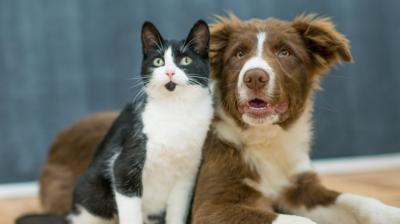Are Essential Oils Safe for my Pet? Part 3: Safety
- posted: Jan. 30, 2018
Are Essential Oils Safe for my Pet?
Part 3: Safety
By Dr. Christa Young, DVM - Bellalago Veterinary Hospital
[This is the third part of a multi-part series about essential oils. You can read Part 1: Basics here and Part 2: Usage here. ]
Social media has been spreading some fairly unfair rumors about essential oils and pets; however, at the base of all of the misstatements is a bit of truth. Essential oils are not without side effects and risk. Always consult your veterinarian before beginning essential oil therapy.
 What should I watch for when using essential oils with my pet?
What should I watch for when using essential oils with my pet?
Any animal, or human for that matter, can be sensitive to any essential oil or blend. As with most sensitivities or allergies (drug, chemical, oil), we often do not know they exist until a pet or person is exposed.
Monitor your pet very closely for negative reactions the first 5 to 10 minutes after starting essential oil therapy. Always start with a smaller amount and diluted oil the first time you try an essential oil treatment to reduce the chances of a negative reaction occurring.
Please watch for the following signs in your pet while using essential oil therapy- stop treatment immediately and seek veterinary help if these are seen:
- Lethargic (mopey and sluggish)
- Rapid or difficult breathing
- Panting
- Drooling
- Squinting the eyes
- Red skin, eyes, or lips
- Any other out-of-the-ordinary changes in your pet
Are essential oils safe to use with my cat?
Yes. Cat’s have a different and unique metabolism from dogs, horses, goats, humans, birds and so on. This means we have to adapt the essential oil therapy to fit the unique metabolism of cats.
Which essential oils are toxic? Which are used with caution?
 Toxic essential oils:
Toxic essential oils:
- Birch
- Bitter Almond
- Boldo
- Calamus
- Camphor
- Garlic
- Horseradish
- Mustard
- Sassafras
- Tansy
- Wintergreen
- Wormseed (chemopodium)
- Pennyroyal
Oils to use cautiously:
- Tea tree – Melaleuca alternifolia is a safer option but needs to be diluted and used in small amounts for a short period of time. Cats are more sensitive to this oil due to the phenols present.
- Citrus oils – animals receiving these oils are hypersensitive to sunlight, so avoid the rays of the sun while using!
- Clove – high in phenols which stimulate the immune system and nervous system but cats are slower at breaking down these compounds. Use smaller amounts and dilute!
- Eucalyptus - Eucalyptus globulus is safe for diffusion, but avoid giving this orally or applying topically. For topical use, look for Eucalyptus radiata.
Cats and dogs who reportedly suffered from essential oil toxicity were treated with an unknown quality of essential oil, overdosed, treated with a product containing other chemicals besides essential oils, or had health issues that complicated their situation. The proper application and use of the essential oil could not be confirmed in these cases either.
Reports of citrus oils being toxic were found when massive overdoses (5 – 10 times the recommended amount) were used and often were a part of an insecticide shampoo or spray containing other chemicals that can be problematic.
Pine oils are toxic when we are talking about Pine-Sol ingestion or exposure, or overdoses to oils with a high concentration of pinene (the oil in pine that makes it delightfully piney). Over 400 essential oils contain some amount of pinene pine oil and do not cause toxic reactions. Spruce and Fir have been used at the appropriate doses without any issues.
Peppermint is safe when diluted appropriately and dosed appropriately. If you give too much and do not dilute this oil, it can cause problems for your pet.
What do I do if my pet has a possible reaction to an essential oil treatment?
 STOP administering the treatment immediately!
STOP administering the treatment immediately!- Call your veterinarian to seek treatment.
- Take the bottle(s) of essential oil and carrier oil you have been using to the appointment.
You should be ready to answer the following questions about your pet and the essential oil therapy
- Brand of oil used?
- Species of the oil? Remember, there are 11 varieties of lavender, at least two varieties of eucalyptus!
- Lot number and expiration of the oil?
- Purchase date of the oils?
- How much are you giving, how often, and what way?
- When did the reaction happen and what did the pet do?
- How long have you been using the oils?
- Any current or recent health issues?
- Any current medications, supplements, over-the-counter products, or parasite preventatives used?
What to expect your veterinarian will do at the appointment:
- Get a history on your pet and perform physical examination.
- Collect samples for lab testing including organ function chemistries, blood count, and a urine analysis.
- Report the possible reaction to the essential oil manufacturer who is required to report the incident to the government agency that oversees them.
Where can I get more information from reliable sources?
- Animal EO by Dr. Melissa Shelton – www.animaleo.info
- Essential Oil Safety, 2nd Edition by Robert Tisserand and Rodney Young (ISBN# 978-0443062414)
- Essential Oils for Natural Pet Care by Melissa Shelton, DVM (ISBN# 978-1466243361)
- American Holistic Veterinary Medical Association - www.ahvma.org
- Find Dr. Melissa Shelton on YouTube!
We recommend using essential oils with your pet only if you're doing so with the guidance of a veterinarian!
If you have any questions, please feel free to reach out to us.
Location
Find us on the map
Bellalago Veterinary Hospital
3809 Pleasant Hill Rd
Kissimmee, FL 34746, US

